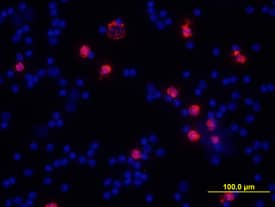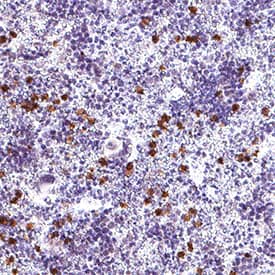Mouse MMP-9 Biotinylated Antibody
R&D Systems, part of Bio-Techne | Catalog # BAF909


Key Product Details
Species Reactivity
Validated:
Mouse
Cited:
Human
Applications
Validated:
Immunocytochemistry, Immunohistochemistry, Western Blot
Cited:
Immunohistochemistry-Paraffin
Label
Biotin
Antibody Source
Polyclonal Goat IgG
Product Specifications
Immunogen
Mouse myeloma cell line NS0-derived recombinant mouse MMP‑9 (R&D Systems, Catalog # 909-MM)
Ala20-Pro730
Accession # P41245
Ala20-Pro730
Accession # P41245
Specificity
Detects mouse MMP-9 in Western blots. In Western blots, approximately 10% cross-reactivity with recombinant human (rh) MMP‑9 is observed and less than 1% cross-reactivity with rhMMP-1, -3, -7, -8, -10, -12, and -13 is observed.
Clonality
Polyclonal
Host
Goat
Isotype
IgG
Scientific Data Images for Mouse MMP-9 Biotinylated Antibody
MMP‑9 in Mouse Splenocytes.
MMP-9 was detected in immersion fixed mouse splenocytes using Goat Anti-Mouse MMP-9 Biotinylated Antigen Affinity-purified Polyclonal Antibody (Catalog # BAF909) at 10 µg/mL for 3 hours at room temperature. Cells were stained using the NorthernLights™ 557-conjugated Streptavidin (red; Catalog # NL999) and counterstained with DAPI (blue). View our protocol for Fluorescent ICC Staining of Non-adherent Cells.MMP-9 in Mouse Thymus.
MMP-9 was detected in immersion fixed paraffin-embedded sections of mouse thymus using Goat Anti-Mouse MMP-9 Biotinylated Antigen Affinity-purified Polyclonal Antibody (Catalog # BAF909) at 5 µg/mL for 1 hour at room temperature followed by incubation with the Anti-Goat IgG VisUCyte™ HRP Polymer Antibody (Catalog # VC004). Before incubation with the primary antibody, tissue was subjected to heat-induced epitope retrieval using Antigen Retrieval Reagent-Basic (Catalog # CTS013). Tissue was stained using DAB (brown) and counterstained with hematoxylin (blue). Specific staining was localized to cytoplasm in thymocytes.Applications for Mouse MMP-9 Biotinylated Antibody
Application
Recommended Usage
Immunocytochemistry
5-15 µg/mL
Sample: Immersion fixed mouse splenocytes
Sample: Immersion fixed mouse splenocytes
Immunohistochemistry
5-15 µg/mL
Sample: Perfusion fixed frozen sections of mouse ovary and thymus
Sample: Perfusion fixed frozen sections of mouse ovary and thymus
Western Blot
0.1 µg/mL
Sample: Recombinant Mouse MMP‑9 (Catalog # 909-MM)
Sample: Recombinant Mouse MMP‑9 (Catalog # 909-MM)
Formulation, Preparation, and Storage
Purification
Antigen Affinity-purified
Reconstitution
Reconstitute at 0.2 mg/mL in sterile PBS.
Formulation
Lyophilized from a 0.2 μm filtered solution in PBS with BSA as a carrier protein.
Shipping
The product is shipped at ambient temperature. Upon receipt, store it immediately at the temperature recommended below.
Stability & Storage
Use a manual defrost freezer and avoid repeated freeze-thaw cycles.
- 12 months from date of receipt, -20 to -70 °C as supplied.
- 1 month, 2 to 8 °C under sterile conditions after reconstitution.
- 6 months, -20 to -70 °C under sterile conditions after reconstitution.
Background: MMP-9
(Catalog # http://www.rndsystems.com/product_results.aspx?k=911-MP">911-MP), the mouse enzyme contains extra sequences in the linker region and in the hemopexin-like domain, respectively.
Long Name
Matrix Metalloproteinase 9
Alternate Names
CLG4B, Gelatinase B, GELB, MANDP2, MMP9
Gene Symbol
MMP9
UniProt
Additional MMP-9 Products
Product Documents for Mouse MMP-9 Biotinylated Antibody
Product Specific Notices for Mouse MMP-9 Biotinylated Antibody
For research use only
